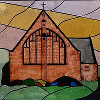A reflection for Bible Sunday 26th October 2025 by Canon Dean Fostekew
“Blessed Lord, who caused all Holy Scriptures to be written for our learning: help us so to hear them, to read, mark, learn and inwardly digest them that, through patience, and the comfort of your holy word, we may embrace and for ever hold fast the hope of everlasting life, which you have given us in our Saviour Jesus Christ, who is alive and reigns with you, in the unity of the Holy Spirit, one God, now and for ever. Amen.”
So read the words of the collect appointed for today, the day we call ‘Bible Sunday’. A Sunday when we give thanks to God for our Scriptures and the insights and truths they contain relating to our understanding of God and his Son, ’The Word made flesh’.
Have you ever pondered, however, how odd our Scriptures truly are? And I say ‘odd’ not in any derogatory way but in a positive and challenging way. What is ‘odd’ about our Scriptures is that, although bound as a single book, they are in fact a ‘library’ of texts from different times, contexts and situations. Some are allegorical stories, some histories and biographies, some letters, some records of visions and prophesy. All very diverse but together forming a ‘whole’ which to quote Anglican doctrine ‘contain enough truth for our salvation’.
The priest, theologian and poet Rachel Mann writes of the Bible :
“ … consider how we handle our Biblical texts. I wonder what our preaching and teaching might look like if we were to be properly honest about the Bible’s complexity and contradictions. What happens to the authority of St.Paul’s letters to Timothy, for example, when we accept that he didn’t write them? … As I am sure you know, that the very word means ‘Library’, and we must wrestle with the fact that is a library of wonder, terror, and hope and NOT an instruction manual with a univocal position.”
Mann is right to challenge our assumptions of Scripture, as for example she says only some of Paul’s epistles were actually written by Paul. Those not written by him but bearing is name do so as an act of respect for Paul by writers who followed him and were inspired by his teachings. For these epistles not to have been written by whom we might think wrote them does not discredit them. They do in fact show how Scripture continues to inspire and influence those who encounter it and are moved to put pen to paper in theological exploration. Something we continue to do today, except our musings and those of others since the compilation of the Bible into the book we have today - by St.Jerome in 400 CE. Books left out don’t get to be part of the Bible but commentaries on it. It is not only Paul who didn’t write all ‘his’ epistles there are for another example at least three Isaiah’s and umpteen other authors involved in most of the books of the Bible, especially in the Old Testament.
What I think, this shows, is how Scripture, can as I have already said, inspire us to think and ponder on God, and for us Christians on the ways and person of Jesus. Scripture has always sought to encourage us to think about what is recorded and why, to pray about what we read and to interpret God’s Word in ways that speak to each of us in the times in which we live.
Thinking of the ‘Bible’ as a ‘library’ is perhaps a way forward for all of us to think about Scripture anew. If we use it as a library, we can explore where the various books it contains come from and what the context they were written in was like at the time. Because we can’t simply impose 21st century ideas and values on writings some over five thousand years old and nor can we simply translate those old words directly into 21st century Scottish society. We have to use these words as starting points for thought, prayer and action - we have to live them out. If we can do this then we bring the Scriptures alive and make them relevant to the lives of people today. They are then not some dusty tome that is rarely read but something living, truly the Word made flesh. And, it is the ‘Living Word’ that is vitally important to us Christians.
We Christians are not people of a book of scriptures. No! We are a people who follow the fleshly embodiment of Scripture ‘The Word’ in the person of Jesus Christ. Jesus is always the ultimate interpretation of Scripture and his words and actions truly bring the Word of God alive. We are called to listen to what Jesus says and to try to follow his ways by continually challenging our own perceptions, prejudices and preferences. In doing so we make Scripture live and allow it grow within us. Scripture should be a living thing for us and not some half-forgotten book on a shelf.
We need to read, mark and learn by inwardly digesting what we hear Scripture telling us. We need to ponder, pray and interpret Scripture so that it nourishes us and becomes the living Word within us.
Mann entitled her piece that I quoted from earlier; ‘We should embrace our oddness’ and it is a challenge we could do well to live up to. Our Bible, our faith is odd but that’s part of its glory and its ability to change lives. Jesus is the Word made flesh, a human being and at the same time divine embodiment of what we call Scripture and the essence of God. How odd is that? But, also how exciting and wonderful is it as well.
